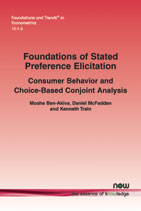Foundations of Stated Preference Elicitation: Consumer Behavior and Choice-based Conjoint Analysis
By Moshe Ben-Akiva, MIT, USA, mba@mit.edu | Daniel McFadden, University of California, Berkeley and USC, USA, mcfadden@econ.berkeley.edu | Kenneth Train, University of California, Berkeley, USA, Kenneth.Train@nera.com
Abstract
Stated preference elicitation methods collect data on consumers by "just asking" about tastes, perceptions, valuations, attitudes, motivations, life satisfactions, and/or intended choices. Choice-Based Conjoint (CBC) analysis asks subjects to make choices from hypothetical menus in experiments that are designed to mimic market experiences. Stated preference methods are controversial in economics, particularly for valuation of non-market goods, but CBC analysis is accepted and used widely in marketing and policy analysis. The promise of stated preference experiments is that they can provide deeper and broader data on the structure of consumer preferences than is obtainable from revealed market observations, with experimental control of the choice environment that circumvents the feedback found in real market equilibria. The risk is that they give pictures of consumers that do not predict real market behavior. It is important for both economists and non-economists to learn about the performance of stated preference elicitations and the conditions under which they can contribute to understanding consumer behavior and forecasting market demand. This monograph re-examines the discrete choice methods and stated preference elicitation procedures that are commonly used in CBC, and provides a guide to techniques for CBC data collection, model specification, estimation, and policy analysis. The aim is to clarify the domain of applicability and delineate the circumstances under which stated preference elicitations can provide reliable information on preferences.
Foundations of Stated Preference Elicitation: Consumer Behavior and Choice-based Conjoint Analysis
Foundations of Stated Preferences Elicitation provides the reader with stated preference data collection methods, discrete choice models, and statistical analysis tools that can be used to forecast demand and assess welfare impacts for new or modified products or services in real markets, and summarize the conditions under which the reliability of these methods has been demonstrated or can be tested. One focus is the collection of preference and related data from consumer responses in hypothetical choice experiments, particularly conjoint analysis methods that have proven useful in market research. Another is the economic theory and statistical analysis of choice behavior, revealed or stated, and an economic framework for forecasting market demand and measuring consumer welfare. The treatment is informed by and benefits from experiments on perceptions and decision-making behavior in cognitive science and behavioral economics, and includes methods that can accommodate features of consumer choice that impact forecast reliability such as anchoring, adaptation to the status quo, and sensitivity to context. However, the authors' emphasis is on forecasting tools developed from traditional economic consumer theory and does not touch on the implications of behavioral consumer theory for demand forecasting.
